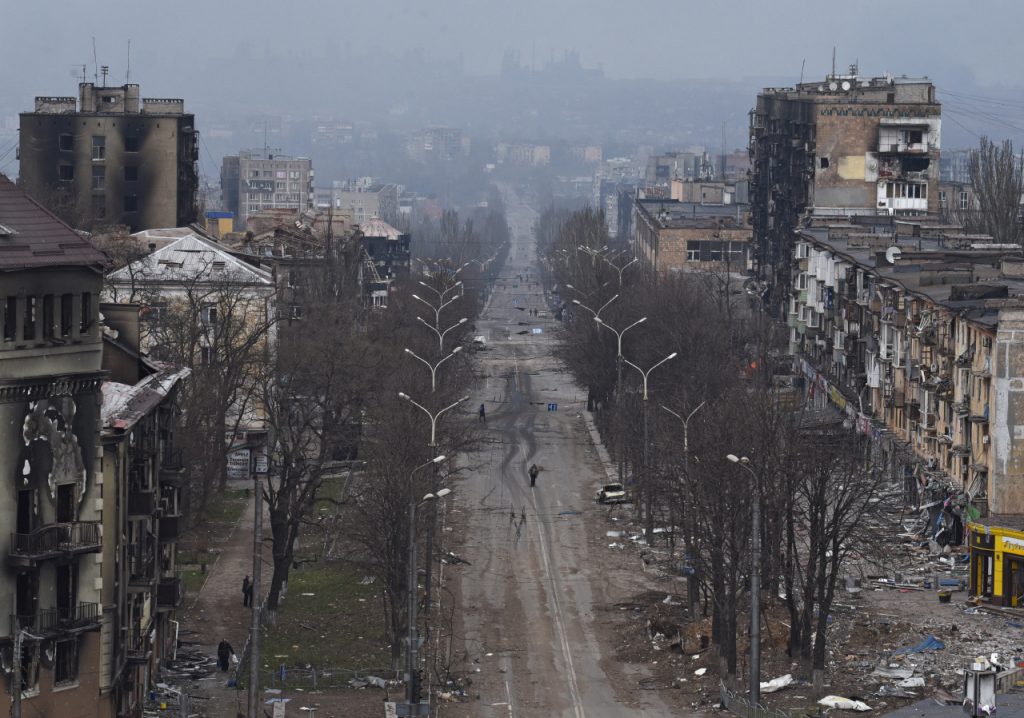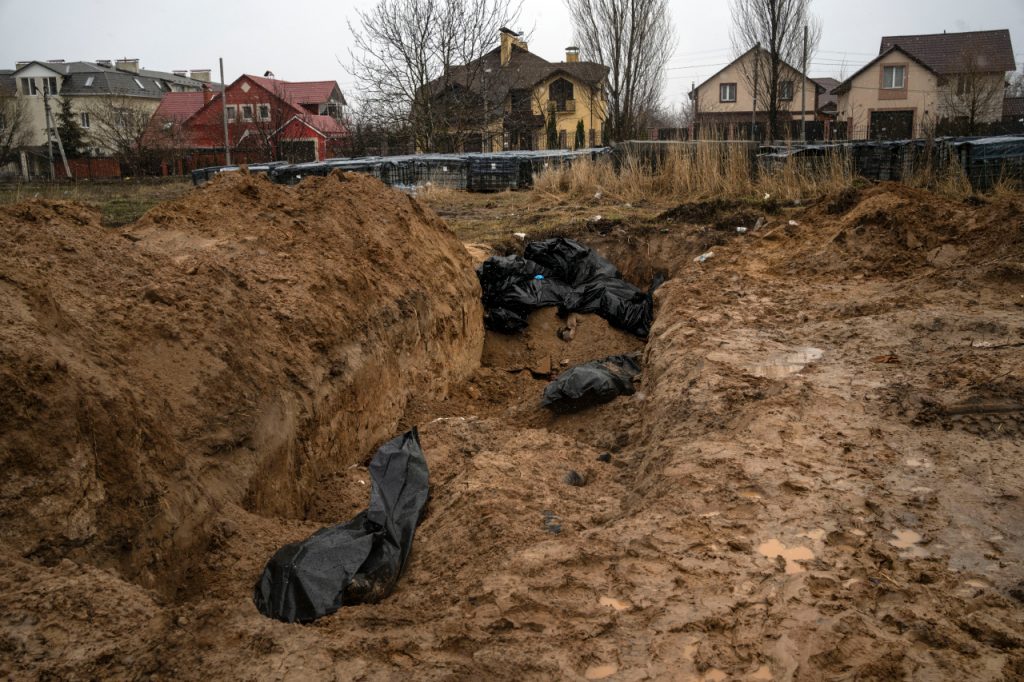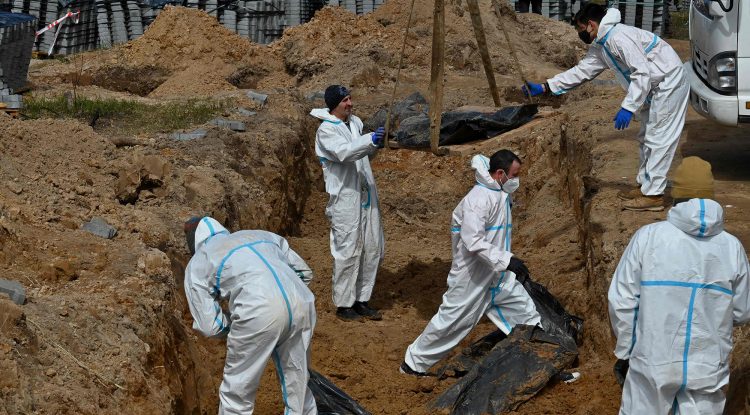Bucha, Irpin, Hostomel. Since the evening of April 2nd, when the first photos from these quiet towns' streets appeared in social and conventional media, their names have become synonymous with the war crimes of Putin’s Russia. Horrendous photographs sprang up around the world: dozens of people shot dead in the streets, next to their houses, in courtyards and on curbs, some with their hands tied and shot in the head, some others with traces of torture. People next to their bikes, shot while going somewhere. Ditches filled with corpses, family members lying next to each other like in Babi Yar, hands and heads sticking from the ground. Bodies with car tires around them, placed by the occupiers with the intent to burn them. Numerous accounts of mass rapes. The total numbers of victims are yet to be found out. 300 dead were reported in Bucha alone. Blood-curdling and spine-chilling apocalyptic scenes, revoking only the biblical “come and see.”
Mariupol is a separate story. What is happening in this city, holding a key position between Donbas and Crimea, is long past the point of war crimes and more and more often referred to as genocide. This is neither a metaphor nor a figure of speech but rather an objective recognition of the fact that Russia’s goal is to destroy the city with a population of half million people.
Genocide does not have to be directed at an ethnic group, it can be any community, including a city population. Five weeks of Mariupol’s blockade, with humanitarian convoys not allowed to enter, have cut its population from the supply of water, food, electricity, heating, medications, and mobile coverage. “Green corridors” are getting shelled, evacuations are being obstructed. People are spending days in lines trying to evacuate without access to heating or food, and many do not manage to leave Mariupol eventually. Many thousands are being forcibly removed to Russia where they are placed in “filtration camps”—that looks more like deportation than evacuation. Testimonies of marauding, looting, rapes and unmotivated killings by Russian soldiers on occupied territories are also piling up.
But genocide is particularly obvious in bombings of residential neighborhoods and other targets in no way related to the governmental or military facilities, most strikingly the annihilation of a maternity hospital (the whole world saw the photos of a fatally injured patient checking if the baby in her womb was okay) and the Mariupol Theater, where over a thousand women and children were hiding in the basement, and 300 of them died as a result of a direct aerial bomb hit (on March 25th, the Mariupol City Council reported that there was “information from eyewitnesses” about the deaths of approximately 300 people as a result of bombing. However, no exact figures based on reports by rescue teams searching the debris were available as of this writing.—ed. Holod).
Today, 90% of Mariupol lie in ruins, there is no single unaffected building in the city, which looks like Coventry, Stalingrad or Dresden after their own bombings. City authorities estimate that five thousand people were killed, 210 of them were children.
These crimes will be dealt with by an international tribunal. Whether it will be possible to arrest the accused and bring them before the court or not, there definitely will be a tribunal. But an even more important trial must be held within the Russian society itself. The tragedy of Bucha and Mariupol, as well as the whole war against Ukraine, should become a subject of surgical reflection, with no anesthesia. It will be needed to understand how the possibility of a genocide could be born within the Russian society and Russian culture, because one cannot just look away from this anthropological catastrophe by referring to it as something external or imposed. All this is being done by the Russian army, by Russian citizens, with complete indifference on the part of the overwhelming majority of the Russian society, either appeased by illusory ignorance, fooled by the government’s allegations of “fake news”, or simply indulgent in the ecstasy of collective approval. How does a society turn into a fascist mass? Is this a collapse, a reducing to zero of not only the Russian civilization but also the Russian culture, if we agree that a national culture is more than an abstract body of works and images learnt in school, that it is a constant process in which a nation (re-)produces its values and symbols? Is culture capable of preventing anything at all? Is writing “poetry after Bucha and Mariupol” possible?

From Grozny to Mariupol
Russia’s war crimes are anything but unique. Just in my generation’s lifetime, there were the massacre of Bosnian Muslims in Srebrenica, Saddam’s use of chemical weapons against Kurds in Iraq, genocide of one million Tutsis in Ruanda and the ongoing extirpation of Uyghurs in Chinese Xinjiang. Moreover, turning to our own recent history, I realize that similar things were done using similar methods in Chechnya in 1994–1996 (also similarly, those events were not called a war but an “operation to restore the constitutional order”) and in Syria since 2015—bombings of civilian buildings (the hospital in Aleppo), mopping-up operations in villages and residential neighborhoods (in Chechen Novye Aldy or Samashki, where 100–300 civilians were summarily killed).
Those crimes became tangential to our collective consciousness, they failed to become a subject of public debate, legal evaluation, or societal memory, just like a million of Afghans killed during the Soviet invasion of 1979–1989 (some evaluate the number of victims during the war in Afghanistan as twice as many.—ed. Holod). This is why the line of the three post-Soviet decades was drawn from Grozny through Aleppo to Mariupol.
But there is a difference. The fact that Afghanistan, Chechnya and Syria were never addressed as war crimes says more about Russians’ colonialism and racism than other things: Chechens, not to mention faraway Afghans and Arabs, were “others”, a different kind of people, and the vague feeling of injustice quickly faded. Ukraine is much closer—geographically, culturally, by blood. Ubiquity of mobile Internet and social media makes any event a hundred times closer, and Ukrainian media are documenting crimes committed by the occupying troops.
For most Russians, however, all these things are not working. They prefer to ignore the humanitarian and moral catastrophe right under their noses, choosing to believe Russian propaganda. I believe that the problem here is not the “zombification” of Russians by the Russian television but their deliberate blindness and deafness, their filtering and repression of uncomfortable information.
As a result, genocide remains unidentified for most of Russia’s population. It is other people who are Fascists (Ukrainians, Americans, Germans from war movies), not you. Mass mentality, even if not always supporting the war, normalizes it and makes it routine. This is the heart of the problem: war crimes are not perceived as something exceptional, they are a civilizational norm. This is the Russian way of war—dirty, bloody, indiscriminate, with scores of dead bodies.
Violence hardly has any legal or cultural limitations in Russia, it is a final argument in the quickly archaizing country. Physical or symbolic, violence is normalized everywhere: in families and schools, in the army and prisons, in relationships between parents and children and between men and women, bosses and their subordinates, police and citizens. The public may frown every time it hears about new cases of mass abuse in correctional colonies, pre-trial jails, or even at the police precinct around the corner, and then forgets about it till next time. And each scandal with leaked videos of torture (e.g. from Vladimir Osechkin’s archives) results in a couple of second-tier officers sacked and then quickly subsides. The system of abuse in the Ministry of Interior and Penitentiary Service institutions continues to flourish and bear fruit, such as good evaluation reports and promotions.
Tragedy of Bucha and Mariupol is nothing more or less than an extrapolation of the Russian violence machine’s habits and practices, applied to the citizens of an individual Ukrainian city and multiplied by the deathly power of modern armaments.

What’s a life worth
There is another innate feature of the Russian civilization, important for the genesis of war crimes—its total disrespect for human life. Never was it so pronounced as during the coronavirus pandemic in 2020-2021.
The pandemic made clear two things in Russia. On the one hand, it was the government’s lack of ability or willingness to fight it. The apparatus of repression and supervision built over the recent years to counter dissent and mass protests was never engaged to address the epidemiological danger. Apart from the strict lockdown in Moscow in March 2020 (which seems to have been Mayor Sobyanin’s own initiative) and occasional show police raids, no serious mask-wearing and social distancing policy was implemented anywhere in Russia, while the vaccination campaign was simply a failure in spite of the fact that the cheap and effective Russian vaccine was accessible early on. Finally, measures to support the population and businesses were ridiculously insufficient.
On the other hand, Russians themselves demonstrated a stoic degree of indifference towards their own lives and health, having displayed the highest prevalence of “COVID dissent”, conspiracy theories and vaccine skepticism in the world. This may be related to the traditional Russian fatalism (“if you’re destined to die, you’ll die”), propensity to taking risks and low value of human life in Russia.
To identify the sources of these attitudes, one may look at the many centuries of slavery (which was not limited to serfs whose bodies did not belong to them: every landlord owed his life and property to the czar, which, according to some historians, accounted for the Russian nobility’s culture of duels and gambling), at the military and colonial type of government, at the police state and practices of institutionalized violence… These sociocultural premises resulted in a unique type of a public contract: the couldn’t-care-less attitude of the higher-ups, who had quickly realized that people are fine with inaccessible healthcare and high mortality levels as long as their usual way of life remains unaffected, was reinforced with the same attitude of the average Russian. As a result, Russia had the record level of excess mortality among developed countries.
Russia has demonstrated this couldn’t-care-less attitude in the war as well—both with regard to civilians’ lives and to its own soldiers who, just like in Chechnya many years ago, are being thrown into the bloodbath without a second thought and driven into the thick of urban areas in tanks and armored vehicles, where they get shot and burnt alive in their steel boxes. Chernobayevka, a village outside Kherson with a population of 16 thousand and an airfield of strategic importance for the Russian army, is an amazing example. The Russian army has taken and lost it 14 times as of this writing (according to the Ukrainian government; the Russian Ministry of Defense reported the airfield’s capture on February 27th and has not commented on any further fighting to defend it since then.—ed. Holod); according to the Ukrainians, Russia lost up to 50 helicopters, 100 tanks and many soldiers and officers, including two lieutenant generals, in the process.
Chernobayevka has already become a meme in Ukraine, synonymous of Russian military failures, incompetence of Russian commanders and their indifference toward losses. We know a lot of such stories from the Great Patriotic War: from the Nevsky Pyatachok bridgehead, where up to a quarter of a million soldiers met their end (in the 1960s, Pravda newspaper reported 200 thousand killed at Nevsky Pyatachok; in the 2000s, however, some Russian historians and the Leningrad Veterans’ Committee estimated these losses at 50 to 68 thousand. In 2019, a book published by the Nevsky Pyatachok museum estimated losses at 110 to 120 thousand.—ed. Holod), to Marshal Zhukov’s reckless frontal assault on the Seelow Heights outside Berlin. Similar scenes are being now reenacted in Russia’s absurd and bloody war against Ukraine.
In this sense, the genocide in Ukrainian cities is something to be expected, a logical and horrible outcome of the last three decades. It is but a manifestation of corruption that has engulfed Russia’s government, its army and its society. Moral decay, professional degradation, corruption and embezzlement, cult of power and low value attached to human life, conformism and indifference in the society—all these things resulted not only in the fact of the criminal war being waged but also in its barbaric methods.
God save us from seeing the “Russian world”, senseless and merciless (a reference to the Russian poet Alexander Pushkin who said that about a “Russian revolt.”—ed. Holod), for which the bell now tolls: Bucha, Irpin, Hostomel, Mariupol.
The opinion expressed in this publication is that of the author and does not necessarily reflect Holod’s opinion.

